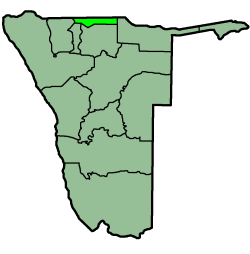Ohangwena region
| Ohangwena Region | |
|---|---|
| Region | |
 Location of the Ohangwena Region in Namibia |
|
| Country | Namibia |
| Capital | Eenhana |
| Government | |
| • Governor | Usko Nghaamwa |
| Area | |
| • Total | 10,706 km2 (4,134 sq mi) |
| Population (2011) | |
| • Total | 245,100 |
| • Density | 23/km2 (59/sq mi) |
| Time zone | South African Standard Time: UTC+1 |
Ohangwena is one of the fourteen regions of Namibia, its capital is Eenhana. The northern and western parts of the region are the most densely populated of this essentially subsistence agricultural region in which small scale mahangu cultivation and the keeping of cattle form the predominant activities. Although the region depends on rain fed agriculture, other crops can be established under intensive cultivation.
The main settlements in the region straddle the good paved road from the Angolan border to Ondangwa, where it joins the Oshakati-Tsumeb trunk road. The eastern part of the region possesses good grazing land, but the shortage of water and poor communications render it uninhabitable at present. There is a tarred road from Onhuno to Okongo that was recently completed, it is thought to greatly increase the area's agricultural potential.
In the north, Ohangwena borders Angola: the Cunene Province, except for a small border with Cuando Cubango Province in the far northeast. Domestically, it borders the following regions:
It is traversed by the northwesterly line of equal latitude and longitude.
The region comprises twelve constituencies:
Ohangwena has 234 schools with a total of 90,703 pupils.
According to the Namibia 2001 Population and Housing Census, Ohangwena had a population of 228,384 (124,823 females and 103,556 males or 83 males for every 100 females) growing at an annual rate of 2.4%. The fertility rate was 5.3 children per woman. 1% lived in urban areas while 99% lived in rural areas, and with an area of 10,703 km2, the population density was 21.3 persons per km2. By age, 15% of the population was under 5 years old, 33% between 5–14 years, 41% between 15–59 years, and 9% 60 years and older. The population was divided into 35,958 households, with an average size of 6.3 persons. 60% of households had a female head of house, while 40% had a male. For those 15 years and older, 59% had never married, 17% married with certificate, 9% married traditionally, 4% married concensually, 4% were divorced or separated, and 6% were widowed.
...
Wikipedia
